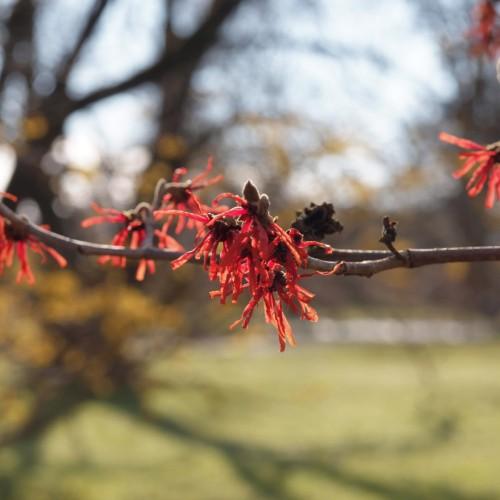
witch hazel
Hamamelis intermedia 'Rubin'
Cycle:
Perennial
Watering:
Average
Hardiness Zone:
5 - 8
Flowers:
Flowers
Sun:
Full sun,part shade
Leaf:
Yes
Growth Rate:
Low
Maintenance:
Low
Drought Tolerant:
Yes
Care Level:
Medium
watering
Witch Hazel (Hamamelis intermedia 'Rubin') requires moderate amounts of water and is best watered deeply and infrequently. It prefers evenly moist soil, however it does not like wet or soggy soil. To help avoid root rot and fungal diseases, never allow the soil to become soaked. Instead, water thoroughly, allowing the soil to dry in between waterings. In average garden conditions Witch Hazel should be watered 2 or 3 times per week during the growing season in spring and summer, and once or twice per month during the winter months. In hotter climates, more frequent watering may be required during the summer months. In hotter and drier climates, consider planting Witch Hazel in part shade to help conserve moisture.
sunlight
For best growth, Witch Hazel (Hamamelis intermedia 'Rubin') should receive plenty of bright but indirect sunlight. In the morning, it should receive a few hours of direct sunlight and in the afternoon, it should receive indirect sunlight. The ideal location for this plant species should be an area with dappled light, meaning the area is illuminated by sunlight that passes through the leaves of a large tree or other vegetation which diffuses the light. It is important to not expose Witch Hazel to direct sunlight during the hottest parts of the day, as this may cause the leaves to burn. In general, about 4-6 hours of bright, indirect sunlight a day is sufficient for this plant species.
pruning
Witch hazel should be pruned in late winter or early spring, just before the start of new growth. The shrub can be pruned lightly to shape it, or pruned more heavily to reduce its size and encourage fuller growth. When pruning, make sure to cut away dead, diseased, and crossed over branches. After pruning, you should thin out the interior of the bush to allow more airflow and sunlight to reach the center of the bush. Be careful not to over-prune, as witch hazel does not tolerate pruning as aggressively as other woody shrubs. Cutting away up to 1-third of the bush at a time is usually safe.
